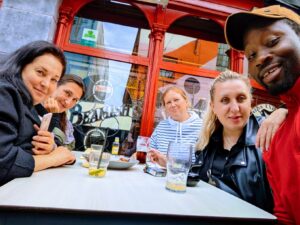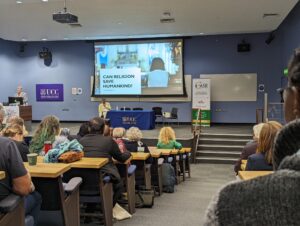The purpose of this study, funded by an AERO grant, was to uncover how bedside…
Cassis Boateng had the privilege of attending the Duke Summer research course on spirituality and health. Boateng is interested in the intersection between mental health, addiction, trauma, and spirituality across the lifespan. Specifically, he wants to know the role of spirituality in building resilience among African American families traumatized by community violence in West Philadelphia, and the neural correlates by which spirituality is expressed. Using the Interdisciplinary Inquiry grant mechanisms offered through the HSNI program, he attended two formative programs. The first provided him a research perspective on the study of religion and spirituality, providing him ideas for further dissertation study. The second provided training on computational approaches, research databases, and quantitative methodologies in the study of religion. Follow along with Cassis as he describes his exciting journey.
In 2021, I had the privilege of attending the Duke summer research institute on Religion, Spirituality, and Medicine. During this training, I had the opportunity to meet fellow scholars from around the world, where I got to learn about the unique role and use of religion and spirituality in different fields and cultures.
Pre-training my understanding of spirituality and religion as applied in research was very minimal. I learned the benefits of separating religion and spirituality in research as well as the clinical utility for both secular and non-secular settings. By the end of the training, I had a fair understanding of what was missing in the literature in my area of interest and what needed to be done to bridge the gap. Specifically, how spirituality and religion are contextualized across different cultures and healthcare systems. The difference in cultural and healthcare contextualization of spirituality and religion hinders the clinical and empirical applications of the two concepts.

Through this training, I formed valuable collaborative relationships with colleagues from other universities which led to the publication “Decline in Religion: A Public Health Crisis” (Boateng, A., Britt, K., Schwartz, B., Xiao, C., Oh, H., & Epps, F. (2021, online). Decline in religiosity: A public health crisis. Journal of Community and Public Health Nursing, 7(11). doi.org:10.4172/2471-9846.1000313). Following this publication, I formed the Spirituality and Health Hub as an avenue for researchers interested in using big data to determine causal relationships between religion, spirituality and health outcomes. Following this publication, I became a fellow at the Yale Program for Medicine, Spirituality and Religion where I work with medical students and professionals to unlock the intersection between religion, spirituality and health. Professionally, I have grown tremendously since attending the Duke training, especially taking into consideration the above accomplishments.
2022 The European Association for the Study of Religions conference (Ireland)

At this conference, I received training on computational approaches, research databases, and quantitative methodologies in the study of religions. Here, I learned the taxing and often complex challenges associated with the computation and analyses of religious variables in big data. It was a needed motivator to help me dig deeper into existing national databases to make sense of how religious variables were captured over time. Religious variable questionnaire in longitudinal data sets do not reflect changes in religiosity over time. The way questions are framed appears to indicate religiosity remains stable over time, yet faith/beliefs can change with the passing of time. There is also the need for religious questionnaire to independently capture the views of participants who consider themselves spiritual but not religious as well as those who consider themselves religious and spiritual. Although religiosity and spirituality are used interchangeable in the literature, the two concepts are different in definition, application and use. Since this training, I have led two papers titled “Religiosity, Multimorbidity, Psychotherapy and Place of Spiritual Leaders Two Decades Later” and “Religious Attendance and Renal Health” where we looked at the place of religious leaders in mental health provision, and the association between religious attendance and cystatin C levels among participants in the Midlife in the United States Series (MIDUS) and Health and Retirement Study (HRS) respectively. The knowledge gained from this training helped me win a research award from Duke University to analyze the “use of mental health resources and life satisfaction among the clergy” using data from the National Religious Leaders Survey (NRLS).
Put together, these trainings have equipped me with the necessary knowledge to work on my pilot grant “perception, application & use of spirituality among Black males who have been victims of firearm injury” which is sponsored by the Hillman Foundation. Future opportunities will lend itself to increase knowledge acquisition and appreciation for the science in my field.
